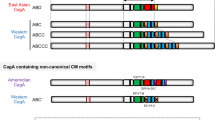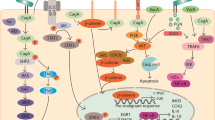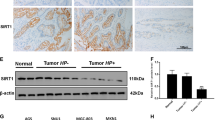Abstract
CagA of Helicobacter pylori is a protein that has been closely associated with gastric cancer and that can intervene with signal pathways in cells. Its precise relationship with the occurrence of gastric cancer, however, remains unclear. The purpose of this study is to investigate whether CagA can promote transformation of normal gastric epithelial cells and to consider via what mechanisms CagA may exert its effects. Transformed colonies were merged in soft-agarose medium after immortalized gastric epithelial cells were transfected with recombinant pLHCX retrovirus with cagA and/or dimethylhydrazine. The number of transformed colonies in the group containing cagA/pLHCX retrovirus, combined with a subthreshold dose of dimethylhydrazine, was more than that for cagA/pLHCX retrovirus or dimethylhydrazine at a subthreshold dose alone. For cagA-transfected cells, only IQGAP-2, R-Ras and B-Raf of the Ras/mitogen-activated protein kinase signal pathway were markedly increased, and the activity of extracellular signal-regulated kinase 1/2 (Erk1/2) kinase was significantly higher than that in dimethylhydrazine-transformed cells or control cells. However, no evidence of alteration of any other molecules of the Ras superfamily was observed in cagA-transfected cells. These findings suggest that CagA can transform gastric epithelial cells through activation of the Erk1/2 pathway; this mechanism may, however, be independent of Ras activation.
This is a preview of subscription content, access via your institution
Access options
Subscribe to this journal
Receive 50 print issues and online access
$259.00 per year
only $5.18 per issue
Buy this article
- Purchase on Springer Link
- Instant access to full article PDF
Prices may be subject to local taxes which are calculated during checkout







Similar content being viewed by others
Abbreviations
- DMH:
-
1,2-dimethylhydrazine
- SHP-2:
-
tyrosine phosphatase containing SH2 homolog
- SV40 LT:
-
simian virus large T antigen
- IVT:
-
in vitro transcription
- PBS:
-
phosphate-buffered saline
- TBS/T:
-
Tris buffer saline/Tween 20
- PMSF:
-
phenylmethylsulfonyl fluoride
- BSA:
-
bovine serum albumin
- EDTA:
-
ethylenediamine tetraacetic acid
- MAPK:
-
mitogen-activated protein kinase
- Erk1/2:
-
extracellular signal-regulated kinase 1/2
- SAPK:
-
stress-activated protein kinase
- DMSO:
-
dimethyl sulfoxide
References
Aguirre-Ghiso JA, Estrada Y, Liu D and Ossowski L . (2003). Cancer Res., 63, 1684–1695.
Amieva MR, Vogelmann R, Covacci A, Tompkins LS, Nelson WJ and Falkow S . (2003). Science, 300, 1430–1434.
Bagrodia S, Derijard B, Davis RJ and Cerione RA . (1995). J. Biol. Chem., 270, 27995–27998.
Bodnar AG, Ouellette M, Frolkis M, Holt SE, Chiu CP, Morin GB, Harley CB, Shay JW, Lichtsteiner S and Wright WE . (1998). Science, 279, 349–352.
Brill S, Li S, Lyman CW, Church DM, Wasmuth JJ, Weissbach L, Bernards A and Snijders AJ . (1996). J. Mol. Cell. Biol., 16, 4869–4878.
Calipel A, Lefevre G, Pouponnot C, Mouriaux F, Eychene A and Mascarelli F . (2003). J. Biol. Chem., 278, 42409–42418.
Chen W, Martindale JL, Holbrook NJ and Liu Y . (1998). Mol. Cell. Biol., 18, 5178–5188.
Cox AD, Brtva TR, Lowe DG and Der CJ . (1994). Oncogene, 9, 3281–3288.
Enroth H, Kraaz W, Engstrand L, Nyren O and Rohan T . (2000). Cancer Epidemiol. Biomarkers Prev., 9, 981–985.
Erhardt P, Schremser EJ and Cooper GM . (1999). Mol. Cell. Biol., 19, 5308–5315.
Fernandez-Sarabia MJ and Bischoff JR . (1993). Nature, 366, 274–275.
He YY, Huang JL and Chignell CF . (2004). J. Biol. Chem., 279, 53867–53874.
Held M, Engstrand L, Hansson LE, Bergstrom R, Wadstrom T and Nyren O . (2004). Helicobacter, 9, 271–277.
Higashi H, Nakaya A, Tsutsumi R, Yokoyama K, Fujii Y, Ishikawa S, Higuchi M, Takahashi A, Kurashima Y, Teishikata Y, Tanaka S, Azuma T and Hatakeyama M . (2004). J. Biol. Chem., 279, 17205–17216.
Higashi H, Tsutsumi R, Fujita A, Yamazaki S, Asaka M, Azuma T and Hatakeyama M . (2002a). Proc. Natl. Acad. Sci. USA, 22, 14428–14433.
Higashi H, Tsutsumi R, Muto S, Sugiyama T, Azuma T, Asaka M and Hatakeyama M . (2002b). Science, 295, 683–686.
Hindley A and Kolch W . (2002). J. Cell Sci., 115, 1575–1581.
Huang RP, Peng A, Hossain MZ, Fan Y, Jagdale A and Boynton AL . (1999). Carcinogenesis, 20, 485–492.
Hubbard SR . (2004). Cell, 116, 764–766.
Ikenoue T, Hikiba Y, Kanai F, Aragaki J, Tanaka Y, Imamura J, Imamura T, Ohta M, Ijichi H, Tateishi K, Kawakami T, Matsumura M, Kawabe T and Omata M . (2004). Cancer Res., 64, 3428–3435.
Ikenoue T, Hikiba Y, Kanai F, Tanaka Y, Imamura J, Imamura T, Ohta M, Ijichi H, Tateishi K, Kawakami T, Aragaki J, Matsumura M, Kawabe T and Omata M . (2003). Cancer Res., 63, 8132–8137.
Keates S, Keates AC, Warny M, Peek Jr RM, Murray PG and Kelly CP . (1999). J. Immunol., 163, 5552–5559.
Keely PJ, Rusyn EV, Cox AD and Parise LV . (1999). J. Cell Biol., 145, 1077–1088.
Keely PJ, Westwick JK, Whitehead IP, Der CJ and Parise LV . (1997). Nature, 390, 632–636.
Kolb TM and Davis MA . (2004). Toxicol. Sci., 81, 233–242.
Kwong L, Wozniak MA, Collins AS, Wilson SD and Keely PJ . (2003). Mol. Cell. Biol., 23, 933–949.
Male R, Bjerkvig R and Lillehaug JR . (1987). Carcinogenesis, 8, 1375–1383.
Mimuro H, Suzuki T, Tanaka J, Asahi M, Haas R and Sasakawa C . (2002). Mol. Cell, 10, 745–755.
Narayan S, Jaiswal AS, Kang D, Srivastava P, Das GM and Gairola CG . (2004). Oncogene, 23, 5880–5889.
Nobuta A, Asaka M, Sugiyama T, Kato M, Hige S, Takeda H, Kato T, Ogoshi K, Keida Y and Shinomura J . (2004). Aliment Pharmacol. Ther., 20 (Suppl 1), 1–6.
Odenbreit S, Püls J, Sedlmaier B, Gerland E, Fischer W and Haas R . (2000). Science, 287, 1497–1499.
Okada T, Hu CD, Jin TG, Kariya K, Yamawaki-Kataoka Y and Kataoka T . (1999). Mol. Cell. Biol., 19, 6057–6064.
Ostrowski J, Woszczynski M, Kowalczyk P, Wocial T, Hennig E, Trzeciak L, Janik P and Bomsztyk K . (2000). Br. J. Cancer, 82, 1041–1050.
Panja A . (2000). Lab. Invest., 80, 1473–1475.
Quaroni A and Beaulieu JF . (1997). Gastroenterology, 113, 1198–1213.
Quartin RS, Cole CN, Pipas JM and Levine AJ . (1994). J. Virol., 68, 1334–1341.
Rieder G, Hofmann JA, Hatz RA, Stolte M and Enders GA . (2003). Int. J. Med. Microbiol., 293, 403–412.
Rutten MJ, Campbell DR, Luttropp CA, Fowler WM, Hawkey MA, Boland CR, Krauss ER, Sheppard BC, Crass RA, Deveney KE and Deveney CW . (1996). Methods Cell Sci., 18, 269–281.
Salh B, Marotta A, Wagey R and Pelech S . (2002). Int. J. Cancer, 98, 148–154.
Selbach M, Moese S, Hurwitz R, Hauck CR, Meyer TF and Backert S . (2003). EMBO J., 22, 515–528.
Shin VY, Wu WKK, Ye YN, So WHL, Koo MWL, Liu ESL, Luo JC and Cho CH . (2004). Carcinogenesis, 25, 2487–2495.
Smoot DT, Sewchand J, Young K, Desbordes BC, Allen CR and Naab T . (2000). Methods Cell Sci., 22, 133–136.
Sugiyama K, Otori K and Esumi H . (1998). Jpn. J. Cancer Res., 89, 615–625.
Terano A, Mach T, Stachura J, Sekhon S, Tarnawski A and Ivey KJ . (1983). Dig. Dis. Sci., 28, 595–603.
Tokieda M, Honda S, Fujioka T and Nasu M . (1999). Carcinogenesis, 20, 1261–1266.
Toouli CD, Huschtscha LI, Neumann AA, Noble JR, Colgin LM, Hukku B and Reddel RR . (2002). Oncogene, 21, 128–139.
Uemura N, Okamoto S and Yamamoto S . (2001). N. Engl. J. Med., 345, 784–789.
Wan PT, Garnett MJ, Roe SM, Lee S, Niculescu-Duvaz D, Good VM, Jones CM, Marshall CJ, Springer CJ, Barford D, Marais R and Cancer Genome Project. (2004). Cell, 116, 855–867.
Wang HG, Millan JA, Cox AD, Der CJ, Rapp UR, Beck T, Zha H and Reed JC . (1995). J. Cell Biol., 129, 1103–1114.
Watanabe T, Tada M, Nagai H, Sasaki S and Nakao M . (1998). Gastroenterology, 115, 642–648.
Whitehead RH, Demmler K, Rockman SP and Watson NK . (1999). Gastroenterology, 117, 858–865.
Zhang L, Ma JL and Pan KF . (1998). Zhonghua Yu Fang YiXue ZaZhi, 32, 67–69 (in Chinese).
Zhu Y, Zheng S, Du Q and Fang P . (2005). World J. Gastroenterol., 11, 880–884.
Zhu Y, Zheng S, Qian K and Fang P . (2004b). Chinese Med. J., 117, 1330–1333.
Zhu Y, Zhong X and Zheng S . (2004a). J. Zhejiang Univ. (Med. Sci.)., 33, 379–384 (in Chinese).
Acknowledgements
We are very grateful to Mrs Jie Lin for her support. We thank Wenzhi Jiang for his technical assistance and the entire laboratory for fruitful discussions. This work was supported by the Natural Science Foundation of China (2001AA227111).
Author information
Authors and Affiliations
Corresponding author
Rights and permissions
About this article
Cite this article
Zhu, Y., Zhong, X., Zheng, S. et al. Transformed immortalized gastric epithelial cells by virulence factor CagA of Helicobacter pylori through Erk mitogen-activated protein kinase pathway. Oncogene 24, 3886–3895 (2005). https://doi.org/10.1038/sj.onc.1208551
Received:
Revised:
Accepted:
Published:
Issue Date:
DOI: https://doi.org/10.1038/sj.onc.1208551
Keywords
This article is cited by
-
Helicobacter pylori pathogen regulates p14ARF tumor suppressor and autophagy in gastric epithelial cells
Oncogene (2018)
-
Fucosyltransferase-4 and Oligosaccharide Lewis Y Antigen as potentially Correlative Biomarkers of Helicobacter pylori CagA Associated Gastric Cancer
Pathology & Oncology Research (2017)
-
Differences in TGF-β1 signaling and clinicopathologic characteristics of histologic subtypes of gastric cancer
BMC Cancer (2016)
-
Helicobacter pylori CagA: A Critical Destroyer of the Gastric Epithelial Barrier
Digestive Diseases and Sciences (2013)
-
Human gastrin mRNA expression up-regulated by Helicobacter pylori CagA through MEK/ERK and JAK2-signaling pathways in gastric cancer cells
Gastric Cancer (2011)



